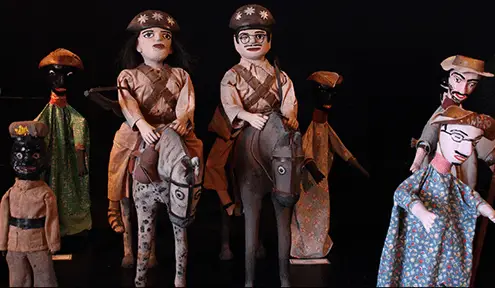Text interpretation, “Artes do Bonecos”, aimed at 2nd year high school students. Go deeper into the traditional culture of the “Mamulengos”! The diverse questions contemplate the specificities of this interesting text.
You can download this Portuguese activity in an editable Word template, ready to print in PDF and also the answered activity.
Download this interpretation from:
SCHOOL: DATE:
PROF: CLASS:
NAME:
Read:
puppet art
Museum in Olinda brings together a collection of typically Brazilian puppets, the mamulengos
Do you know what a mamulengo is? If you are from the Northeast of the country, you should know; if you are from other regions, you must know him as a puppet. Mamulengo is a doll, usually made of cloth and wood, which can be worn by hand to make small plays. In Pernambuco, it is very traditional and part of popular culture – so much so that it won a special museum!
Espaço Tiridá – Mamulengo Museum, in Olinda, brings together a huge collection of typically northeastern puppets from various periods. There you will meet a lot of curious characters from popular theaters. There are, of course, Lampião and Maria Bonita; the priest; the mourners (who are paid to cry at the funerals of others) and Tiridá, a funny boy, who always speaks in rhymes, and gives the museum its name. There are so many interesting and colorful dolls that you leave there wanting to play!

(Photo: Sofia Moutinho)
Tiridá Space – Mamulengo Museum
Rua de São Bento, nº 344, Varadouro, Olinda (PE)
Tuesday to Sunday, from 10 am to 5 pm
Suggested price: R$ 2.00
Information: (81) 3493-2753
Available in: http://chc.org.br/arte-dos-bonecos/. Accessed on: May 21, 2016.
Question 1 - Check the alternative that outlines the purpose of the text above:
a) To value the art of puppets.
b) Highlight the northeastern traditions.
c) Describe Lampião and Maria Bonita.
d) Publicize the “Museu do Mamulengo”.
Question 2 - In the passage “Mamulengo is a puppet, usually made of cloth and wood, which can be worn in the hand to make small plays.”, the signaled sequence has the function of:
a) nominal complement
b) bet
c) predicative of the subject
d) vocative
Question 3 - In “If you for the Northeast of the country should know; if for from other regions […]”, the highlighted verb indicates:
a) hypothesis
b) order
c) desire
d) certainty
Question 4 – Identify the passage where you notice the omission of a sentence term.
Then she responds:
a) What is the omitted term?
b) Why was the omission made?
Question 5 - A record of informal language can be found in:
a) “Museum in Olinda brings together a collection of typically Brazilian puppets […]”.
b) “[…] it is a puppet, usually made of cloth and wood […]”.
c) “There, you will find a lot of curious characters from popular theaters.”.
d) “There are so many interesting and colorful dolls […]”.
By Denyse Lage Fonseca – Graduated in Languages and specialist in distance education.
At answers are in the link above the header.
 report this ad
report this ad